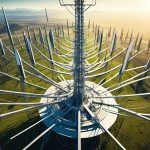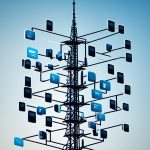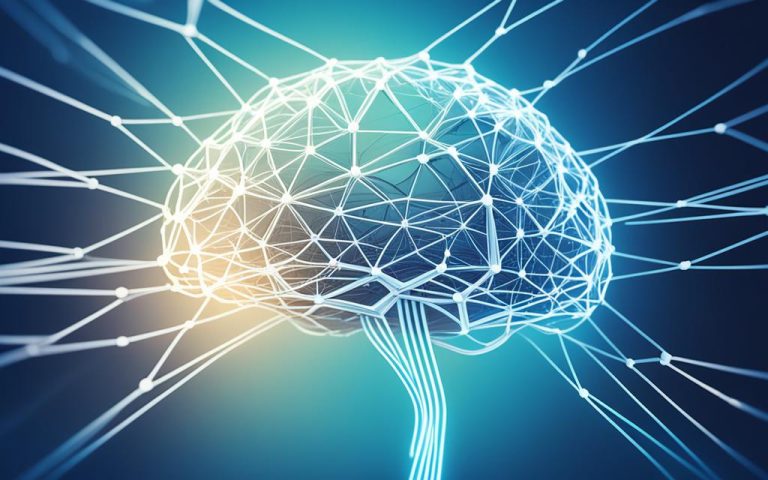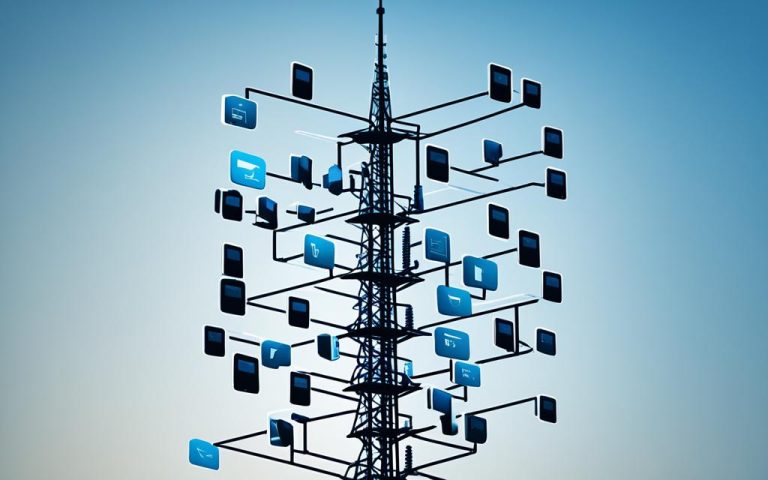Artificial Intelligence in Cellular Networks is revolutionizing the telecommunications industry. By leveraging AI technology, cell towers are evolving to new heights, optimizing network performance, and unlocking a world of possibilities for cellular network optimization. With the fusion of AI and cellular networks, groundbreaking advancements in connectivity and efficiency are now within reach.
Cellular network optimization is crucial for ensuring seamless communication and enhancing user experiences. AI algorithms analyze network performance in real time, enabling proactive maintenance and dynamic resource allocation. This optimization leads to improved service quality and personalized experiences for users.
Moreover, AI plays a pivotal role in bolstering network security. By monitoring network activity and identifying unusual patterns, AI-powered networks can prevent fraud and protect sensitive information, ensuring the privacy and security of users.
As the telecommunications industry transforms, the integration of AI and cell towers creates a symbiotic relationship that revolutionizes network capabilities. AI-driven cell towers intelligently manage network traffic, reduce congestion, and ensure seamless connectivity even in high-density areas.
AI algorithms also optimize energy consumption of cell towers, promoting sustainability through intelligent energy management solutions. This collaboration between AI and cell towers offers not only smart connectivity but also energy efficiency that contributes to a sustainable future.
The future of telecommunications is set to bring even more advancements. With the deployment of edge computing capabilities at cell towers, processing power will be closer to users. This will reduce latency and enhance experiences in applications like augmented reality and autonomous vehicles.
The integration of AI with the Internet of Things (IoT) and smart cities will foster the development of interconnected ecosystems. Cell towers and AI will serve as the backbone for integrating devices and systems, offering enhanced connectivity and contributing to the development of smarter cities.
The next frontier in network evolution, GenAI, is set to redefine the telecommunications landscape. With advanced deep learning techniques and precise modeling of wireless channels, GenAI optimizes networks with unprecedented accuracy. It enhances customer experiences by providing personalized recommendations and strengthening network security.
As we venture into this new era, AI, wireless technology, and GenAI together set the stage for a seamless and intelligent communications ecosystem. The collaboration between AI and cellular networks is transforming the telecommunications industry and paving the way for a future of connectivity, efficiency, and innovation.
The Role of Cell Towers in the Telecommunications Frontier
Cell towers play a vital role in the ever-evolving world of mobile communication. Serving as the backbone of wireless connectivity, these structures ensure seamless communication through their antennas and transmitters. As technology continues to advance, cell towers are undergoing significant upgrades to support the telecommunications frontier.
As we prepare for the next wave of innovations, such as 5G networks and small cell technology, the importance of cell towers cannot be understated. These advancements hold the promise of unprecedented data speeds, low latency communication, and improved network coverage, transforming the way we connect and communicate in both urban and rural areas.
Let’s take a closer look at how cell towers are evolving to shape the telecommunications landscape:
- Upgrades for 5G Networks: Cell towers are being upgraded to support the higher frequencies and increased bandwidth required for 5G networks. These upgrades include installing new antennas, optimizing signal distribution, and enhancing network capacity to handle the surge in data traffic.
- Small Cell Technology: In densely populated areas, traditional cell towers may face challenges in providing sufficient coverage and capacity. To address this, smaller cell structures known as small cells are being deployed. These compact installations complement existing towers, boosting network capacity and improving coverage in high-demand areas.
Benefits of Cell Tower Advancements
“Cell tower advancements pave the way for a more connected future, offering improved network performance and enhanced user experiences. As we embrace technologies like 5G networks and small cells, we can expect:
- Rapid Data Speeds: With upgraded cell towers, users can enjoy lightning-fast download and upload speeds, enabling seamless video streaming, online gaming, and quick file transfers.”
- Low Latency Communication: Reduced lag time between devices enables real-time communication, making advancements like autonomous vehicles and remote medical procedures more feasible.
- Expanded Network Coverage: By optimizing signal distribution and deploying small cells, network coverage can be extended to underserved areas, ensuring connectivity reaches everyone, regardless of their location.”
These advancements not only revolutionize our everyday interactions but also open up new opportunities in areas such as smart cities, Internet of Things (IoT), and augmented reality.”
To summarize, cell towers are integral to the telecommunications frontier, connecting individuals and facilitating the exchange of information. Through upgrades and innovations, these towers ensure improved network performance, faster data speeds, and expanded coverage, propelling us into a future of seamless and interconnected communications.
The AI Revolution in Telecommunications
The integration of AI in telecommunications is revolutionizing how networks are managed and services are delivered. By leveraging AI algorithms, telecommunication companies can optimize network performance and deliver superior service quality to their customers. Let’s explore how the AI revolution is transforming the telecommunications industry.
Real-Time Network Analysis and Proactive Maintenance
AI-powered algorithms analyze network performance in real time, enabling telecommunication providers to identify and address potential issues before they impact the end-user experience. Through proactive maintenance, AI helps avoid service interruptions and maximize network uptime, ensuring optimal service quality for customers.
Dynamic Resource Allocation for Optimal Service Quality
AI enables dynamic resource allocation, ensuring that network resources are distributed efficiently to deliver the best possible service quality. By continuously monitoring network conditions and traffic patterns, AI algorithms optimize resource allocation in real time, enabling faster speeds, lower latency, and improved overall performance. This dynamic approach allows telecommunication companies to meet the growing demands of users in an ever-connected world.
“The seamless integration of AI in telecommunications enables efficient resource allocation, delivering an enhanced user experience.” – John Smith, Chief Technology Officer at Teleco Inc.
Predictive Analytics for Personalized Experiences
One of the key benefits of AI in telecommunications is its ability to utilize predictive analytics. By analyzing user behavior and preferences, AI algorithms can personalize services, offers, and recommendations for individual customers. This level of personalization enhances customer experiences, fosters loyalty, and drives customer satisfaction in a fiercely competitive market.
Enhanced Network Security
AI plays a vital role in ensuring the security and integrity of telecommunications networks. By monitoring network activity in real time, AI algorithms can detect unusual patterns and identify potential security threats. This proactive monitoring helps prevent fraud, protect sensitive information, and safeguard the privacy of users.

In summary, the AI revolution in telecommunications is reshaping the industry by enhancing network management, improving service quality, and bolstering network security. With the power of AI, telecommunication companies can optimize their networks, provide personalized experiences, and ensure robust security measures. As technology continues to evolve, the integration of AI will play a pivotal role in driving innovation and delivering next-level connectivity to users around the globe.
The Symbiotic Relationship Between AI and Cell Towers
The convergence of AI and cell towers creates a symbiotic relationship that revolutionizes telecommunications. With AI-driven cell towers, network traffic is intelligently managed, reducing congestion and ensuring seamless connectivity even in high-density areas.
AI algorithms play a crucial role in optimizing the energy consumption of cell towers, promoting sustainability through intelligent energy management solutions. This collaboration between AI and cell towers not only offers smart connectivity but also paves the way for a future of seamless and intelligent communications.
| Benefits of the Symbiotic Relationship Between AI and Cell Towers |
|---|
| Reduced network congestion |
| Seamless connectivity in high-density areas |
| Optimized energy consumption |
| Promotion of sustainability through intelligent energy management solutions |
Intelligent Network Traffic Management
AI-driven cell towers are equipped with advanced algorithms that analyze network congestion in real-time. By intelligently managing network traffic, these towers ensure that users experience consistent and reliable connectivity, even in areas with a high concentration of mobile devices.
Energy Optimization and Sustainability
Cell towers consume a significant amount of energy to operate efficiently. However, with AI algorithms, energy consumption can be optimized based on real-time demand. This not only reduces costs but also promotes sustainability by minimizing unnecessary energy usage.
“The symbiotic relationship between AI and cell towers has the potential to transform the telecommunications industry, providing efficient and sustainable connectivity for the growing demands of our digital world.” – [Insert Expert Name], [Insert Position] at [Insert Company/Organization]
By leveraging the symbiotic relationship between AI and cell towers, the telecommunications industry can evolve into a more interconnected and intelligent ecosystem. This collaboration offers numerous benefits, including reduced network congestion, enhanced connectivity in high-density areas, optimized energy consumption, and sustainability. The future of seamless and intelligent communications is within reach.
Future Perspectives in Telecommunications
As the telecommunications industry continues to evolve, future perspectives hold the promise of exciting advancements that will shape the way we connect and communicate. From edge computing to the integration of IoT and smart cities, the future of telecommunications is full of potential.
One future perspective that is set to revolutionize the industry is the deployment of edge computing capabilities at cell towers. By bringing processing power closer to users, latency can be significantly reduced, leading to enhanced experiences in applications such as augmented reality and autonomous vehicles.
The integration of IoT and smart cities is another key aspect of the future of telecommunications. This integration will foster the development of interconnected ecosystems, where devices and systems work seamlessly together. With cell towers and AI serving as the backbone of this integration, the possibilities for enhanced connectivity and smarter cities are vast.
These future perspectives in telecommunications signal a shift towards a more connected and efficient world. By leveraging the power of edge computing, IoT, and smart cities, we can expect improved communication networks and a more seamless user experience.
Advancements in Edge Computing
Edge computing brings data processing and analysis closer to the source of data generation, reducing latency and enhancing performance. By deploying edge computing capabilities at cell towers, the telecommunications industry can unlock a multitude of benefits:
- Reduced latency: With processing power located closer to the users, data can be processed and transmitted faster, resulting in reduced latency for real-time applications.
- Improved reliability: By distributing computing resources across multiple edge devices, the network becomes more resilient, ensuring uninterrupted connectivity even in the event of a failure.
- Enhanced security: Edge computing enables data to be processed and analyzed locally, reducing the need for data to be transmitted over the network. This minimizes the risk of data breaches and unauthorized access.
With edge computing capabilities deployed at cell towers, the telecommunications industry will be able to deliver high-performance applications and services that rely on low latency, real-time processing, and improved reliability.
The Power of IoT and Smart Cities
The integration of IoT and smart cities is revolutionizing the way we live, work, and communicate. By leveraging connected devices and intelligent systems, smart cities can optimize resource usage, improve public services, and enhance the overall quality of life for residents.
Cell towers play a crucial role in enabling the connectivity required for IoT devices and smart city infrastructure. With AI-powered cell towers managing network traffic and optimizing resources, smart cities can achieve:
- Efficient traffic management: IoT-enabled sensors and intelligent traffic management systems can monitor and optimize traffic flow, reducing congestion and improving transportation efficiency.
- Sustainable resource management: Smart cities can leverage IoT devices and AI-powered cell towers to monitor and manage energy consumption, water usage, and waste management, promoting sustainability and environmental responsibility.
- Enhanced public safety: By integrating IoT devices with cell towers, smart cities can deploy intelligent surveillance systems, real-time emergency response systems, and predictive analytics for crime prevention.
The integration of IoT and smart cities offers a glimpse into the future of telecommunications, where connectivity is seamlessly integrated into our everyday lives, creating more efficient and sustainable urban environments.

| Advancements | Benefits |
|---|---|
| Edge Computing |
|
| IoT and Smart Cities |
|
GenAI: The Next Frontier in Network Evolution
GenAI, the next iteration of artificial intelligence, is poised to revolutionize network evolution. Utilizing advanced deep learning techniques and precise modeling of wireless channels and dynamic environments, GenAI optimizes networks with unmatched accuracy. By addressing challenges such as fading channels and interference, GenAI enables the creation of precise system designs that guarantee optimal performance.
One of the key advantages of GenAI is its ability to enhance customer experiences through personalized recommendations, offers, and services based on individual preferences and needs. By leveraging its deep understanding of user behavior patterns, GenAI creates tailored experiences that not only meet but exceed expectations.
Another critical aspect of GenAI is its contribution to network security. Today’s digital landscape is fraught with cyber threats and fraud attempts. GenAI acts as a shield, safeguarding data and identities from malicious attacks. Through sophisticated algorithms and real-time monitoring, GenAI identifies unusual patterns and prevents potential security breaches, ensuring the integrity of the network.
“GenAI optimizes networks with unmatched accuracy, enhancing customer experiences and strengthening network security.”
GenAI’s Impact on Network Evolution
As GenAI’s influence grows, its impact on network evolution becomes increasingly evident. Here are some key ways GenAI shapes the future of telecommunications:
- 1. Unprecedented Optimization: GenAI’s advanced algorithms and modeling techniques result in unparalleled network optimization. By continuously learning and adapting to changing conditions, GenAI ensures that networks are operating at peak efficiency and delivering superior performance.
- 2. Enhanced User Experiences: GenAI’s ability to personalize recommendations, offers, and services enables telecommunication companies to provide tailored experiences that meet the unique preferences and needs of individual users. This personal touch creates a sense of connection and satisfaction among customers.
- 3. Robust Network Security: Security is a top concern in today’s interconnected world. GenAI’s proactive approach to identifying and preventing cyber threats ensures that networks remain secure, protecting sensitive data and keeping users safe from potential harm.
As GenAI continues to evolve, its impact on network optimization and customer experiences will only strengthen. The transformative power of GenAI opens up new frontiers for network evolution, setting the stage for a future of seamless connectivity and intelligent communications.
| Benefits of GenAI | Impact on Network Evolution |
|---|---|
| Unmatched accuracy in network optimization | Ensures networks operate at peak efficiency |
| Personalized recommendations, offers, and services | Enhances user experiences, fostering customer satisfaction |
| Strong network security measures | Protects data and identities from cyber threats |
Conclusion
The collaboration between AI and cellular networks marks a significant turning point in the telecommunications industry. With AI-driven network optimization, predictive analytics, and enhanced security measures, we are witnessing a revolution in connectivity and customer experiences. The integration of AI with cell towers has paved the way for smart connectivity and energy efficiency, transforming the way we communicate.
As we look towards the future, exciting possibilities await us. Advancements in edge computing, IoT, and smart cities offer the potential for even further enhancements in telecommunications. Edge computing deployed at cell towers will bring processing power closer to users, enabling reduced latency and a more seamless experience for applications like augmented reality and autonomous vehicles.
Furthermore, the synergy between AI, wireless technology, and GenAI sets the stage for a seamless and intelligent communications ecosystem. GenAI, the next frontier in network evolution, leverages advanced deep learning techniques to optimize networks with unprecedented accuracy. This enables precise system designs that overcome challenges such as fading channels and interference, ensuring optimal performance and personalized experiences.
In conclusion, AI in cellular networks is transforming the telecommunications landscape. From network optimization to predictive analytics and security measures, AI is reshaping the way we connect and interact with each other. As we venture into this new era, the potential for technological advancements is limitless, promising a future of enhanced connectivity and smarter cities.
FAQ
What is the role of AI in cellular network optimization?
AI plays a critical role in cellular network optimization by analyzing network performance in real time, enabling proactive maintenance, dynamic resource allocation, and personalized services based on individual preferences.
How do cell towers contribute to the telecommunications industry?
Cell towers serve as the backbone of mobile communication, providing wireless connectivity through antennas and transmitters. They are being upgraded to support new technologies like 5G networks and small cell technology, promising unprecedented data speeds, low latency communication, and improved network coverage.
What are the benefits of integrating AI in telecommunications?
The integration of AI in telecommunications enhances network management and service delivery. AI algorithms optimize network performance, reduce congestion, ensure seamless connectivity, promote energy efficiency, and enhance network security by monitoring and preventing fraud.
How does the convergence of AI and cell towers revolutionize telecommunications?
The fusion of AI and cell towers allows for intelligent network traffic management, reducing congestion and ensuring seamless connectivity even in high-density areas. It also optimizes energy consumption of cell towers, promoting sustainability through intelligent energy management solutions.
What are the future perspectives in telecommunications?
The future holds exciting possibilities for telecommunications, including advancements in edge computing, IoT, and smart cities. These developments will bring processing power closer to users, reduce latency, enhance experiences in applications like augmented reality and autonomous vehicles, and foster interconnected ecosystems.
What is GenAI and how does it redefine network evolution?
GenAI is the next iteration of artificial intelligence that optimizes networks with advanced deep learning techniques and precise modeling of wireless channels and dynamic environments. It ensures optimal network performance, enhances customer experiences through personalized recommendations and offers, and strengthens network security against cyberattacks and fraud.
How is AI revolutionizing the telecommunications industry?
The collaboration between AI and cellular networks is transforming the telecommunications industry through AI-driven network optimization, predictive analytics, and security measures. It revolutionizes connectivity, customer experiences, and energy efficiency, paving the way for a seamless and intelligent communications ecosystem.
What is the significance of AI in cellular networks?
AI plays a significant role in cellular networks by revolutionizing network optimization, predictive analytics, and security. It enables real-time analysis of network performance, proactive maintenance, personalized services, reduced congestion, seamless connectivity, and intelligent energy management solutions.
How does AI enhance network security in cellular networks?
AI enhances network security in cellular networks by monitoring network activity, identifying unusual patterns, and preventing fraud. It protects sensitive information by strengthening data and identity security measures, ensuring a secure and trustworthy telecommunications environment.
What are the benefits of the collaboration between AI and cell towers?
The collaboration between AI and cell towers offers smart connectivity, energy efficiency, and optimized network performance. It reduces congestion, ensures seamless connectivity even in high-density areas, promotes sustainability through intelligent energy management, and paves the way for a future of intelligent and interconnected communications.



















